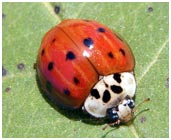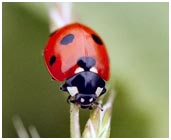Ladybug is a small insect belonging to the family of beetles. To know some interesting facts and amazing information about ladybugs, read on.
Facts About Ladybug
Ladybugs are small insects, belonging to the family of beetles. They are known by various names at different places, namely ladybirds, ladybugs, lady beetles, etc. The insects are seen inhabiting almost all the countries on the world, with over 450 species in North America itself. Ladybug is found in different colors, the common being, yellow, orange and scarlet, usually with small black spots on their wing covers and black legs, head and antennae. Many species are considered as useful, as they feed on aphids and scale insects, which act as pests in gardens and agricultural fields. Moreover, it is even believed to bring good luck. It is said that the name ‘Ladybug’ was kept after Mother Mary, also associated as ‘Our Lady’. Some believe that the seven-spot ladybug depicts Virgin Mary’s seven sorrows and seven joys. In England, ladybugs are also called as ‘ladybirds’. Check out some interesting facts and amazing information about ladybug.

Fast Facts
Kingdom: Animalia
Phylum: Arthropoda
Class: Insecta
Order: Coleoptera
Genus: Coccinella
Family: Coccinellidae
Species: Above 5000
Size: 1 to 10mm (depending upon the species)
Diet: Onmivore, Aphids, Scale Insects, Mealybugs and Mites
Natural Habitat: Throughout the world
Age: 2 - 3 years
Gestation Period: 4 - 7 weeks
Number of Offspring: 1 - 2 (depending upon the species)
Interesting And Amazing Facts About Ladybug
- A female ladybug lays more than 100 eggs in her lifetime. At a time, the female can lay a cluster of about 30 eggs, which are left on plants, usually among colonies of mealybugs, aphids or scale insects.
- The eggs hatch after three or five days and the larvae feed on aphids or other soft bodied insects. These larvae then pupate to become adults within seven to ten days. One larva can eat over 400 aphids till it enters the pupal phase.
- When ladybugs are in the larva phase, they are fierce unlike their adults.
- Ladybugs are attracted to certain flowering plants to feed on pollen. They are fennels, dills, caraways, cilantros, yarrows, geraniums, corepsis, dandelions, cosmos, wild carrots and tansies, to name a few.
- These beetles usually come in red, yellow or orange with black spots on its dome-shaped back.
- While flying, a ladybug beats wings 85 times in a sec.
- There are more than 5,000 species and about 450 of them are found in North America.
- The most common type of ladybug species include the convergent ladybugs that has 13 spots, the nine-spotted ladybugs and the two-spotted ladybugs. There is another type of ladybug called the Mexican bean beetle and these feed on leaves, flowers and other plants.
- While eating, ladybugs chew from side to side and not up and down like humans.
- Ladybugs produce a chemical substance that smells and tastes horrible. This substance is a reflex bleed called ‘hemolymph’ produced from its leg joints. It prevents them from predators and birds.
- A ladybug bites if you squeeze it, but the bite doesn’t hurt.
- The spots on the body of the ladybug fade, as it gets older.
- In winters, ladybugs do not eat and survive on their stored fat. During this season, these form clusters and take refuge under a bark, among leaves or any other place to hide themselves.
- The size of male ladybug is smaller than the female.
- In many countries, like Iran and Switzerland, ladybugs are considered auspicious and symbols of good luck.
- Ladybugs are found in many colors. Some have spots, while some do not.
- Ladybugs even use their feet to smell.
- These creatures survive in mild climates and live in the warmest parts of the world.
- When exposed to danger, ladybugs act dead by tucking their heads and legs under their bodies and will stay still until the predator is out of sight.
- These are usually 1/16 to 3/8 of an inch in length.
- Ladybugs consume plant-eating insects including mealybugs, aphids, scale insects and for this reason, these bugs are bred commercially and sold to farmers and gardeners.


See also
More from iloveindia.com
- Home Remedies | Ayurveda | Vastu | Yoga | Feng Shui | Tattoos | Fitness | Garden | Nutrition | Parenting | Bikes | Cars | Baby Care | Indian Weddings | Festivals | Party ideas | Horoscope 2015 | Pets | Finance | Figures of Speech | Hotels in India : Delhi | Hyderabad | Chennai | Mumbai | Kolkata | Bangalore | Ahmedabad | Jaipur
- Contact Us Careers Disclaimer Privacy Policy Advertise With Us Lifestyle Sitemap Copyright iloveindia.com. All Rights Reserved.




